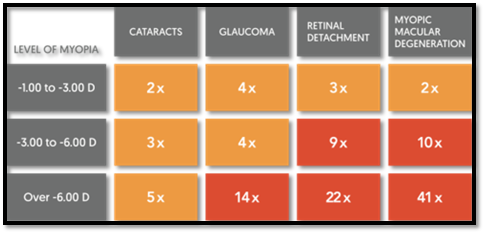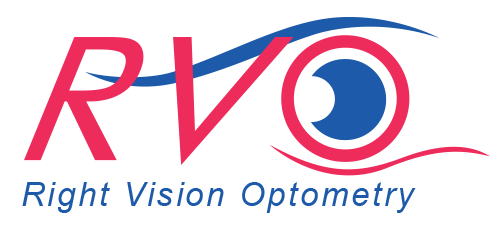Myopia, commonly known as nearsightedness, is a worldwide epidemic and happens when the eye is longer than normal. Myopia is growing increasingly common today and children are being affected.
Experts say that Myopia management is an effective way to prevent its progression so that you and your family members have healthy, lifelong vision.
Myopia has a genetic factor, and modern lifestyles with the use of digital devices may also influence the development/progression of myopia. Leaving myopia unmanaged may contribute to more severe eye health complications and sight threatening conditions later in life. Some of these long-term complications of myopia include retinal detachment, myopic maculopathy, glaucoma, and cataracts. Below is a graph of the increased risk of ocular complications with rising prescription.

Signs
- Blurred vision for distance.
- Excessive blinking.
- Squinting.
- Frequent eye rubbing.
- Holding things close to their face.
- Closing one eye for reading.
- Frequent headaches.
- Tired-eyes.
1) Ortho-K
What is Ortho-K?
Orthokeratology, or Ortho-K, serves as a technique to temporarily reshape the cornea using personalized contact lenses. This approach aims to address myopia. During your sleep, these specially crafted lenses will mold the cornea, the eye’s frontal surface. Consequently, you can experience clear vision the following day without the need for any corrective lenses. This method proves effective not only for rectifying refractive issues such as nearsightedness, astigmatism, hyperopia, and presbyopia but also for decelerating the advancement of childhood myopia.
Who is a good candidate? Most people with mild to moderate nearsightedness can consider orthokeratology. This involves wearing special contact lenses overnight that temporarily reshape the cornea. You can stop using these lenses whenever you want since the changes are not permanent. Orthokeratology is a good option if you’re looking for an alternative to LASIK and other eye surgeries to improve your vision. It’s also useful for individuals who play sports or work in dusty places, where regular contact lenses might be troublesome.
What results can you expect?
- 65% of patients are able to achieve 20/20 during the day without glasses or contacts.
- 90% of patients are able to achieve 20/30 or better.
How long until I see the results?
While there might be some noticeable improvement to your vision within a day or two of utilizing Ortho-K, the comprehensive impact might require several weeks to become fully evident. Throughout this period, your visual acuity may not be as distinct as it was with glasses or contact lenses, and it’s probable that you’ll observe some degree of glare and halos around light sources.
In some cases, you might require a temporary set of eyeglasses for specific activities, such as nighttime driving, until your vision is completely corrected by the Ortho-K lenses.
2) MiSight
How does MiSight Soft Contact lenses work?
MiSight® 1 day lenses are disposable soft contacts from CooperVision™. These lenses use innovative ActivControl™ technology to correct nearsightedness while slowing down its progression. In a three-year period, studies show that MiSight lenses reduce the progression of myopia by almost 60%.
This is the newest technology in Myopia Control. Other methods include rigid contact lenses (Ortho-K) and Atropine drops.
During your comprehensive eye exam, Dr. Silva-Celada will determine if your child needs myopia control.
Who is a good candidate for MiSight contact lenses?
MiSight daily lenses are designed for children aged 8-12. To qualify for this specific treatment, your child must have mild to moderate myopia (between -0.75D and -4.00D) with less than 0.75D of astigmatism. If your child has significant astigmatism, Dr. Silva may recommend another method of myopia management to effectively control their astigmatism at the same time.
Myopia is a worldwide epidemic and younger children are being affected. Prescriptions are rapidly increasing and so our goal is to slow down this progression so that you and your family members have healthy, lifelong vision. Below is a graph of the increased risk of ocular complications with rising prescription.
To learn more about myopia management, call the office or click the button to schedule an appointment.
3) Atropine
Atropine eye drops are applied once a day and normal correction (glasses or contact lenses) are worn throughout the day. Applying atropine eye drops dilates the pupils and temporarily paralyzes the focusing muscle inside the eye. It also relaxes the eyes’ focusing mechanisms. Research has suggested that myopia in children may be connected to focusing fatigue so using atropine can control myopia by disabling the focusing mechanism.
